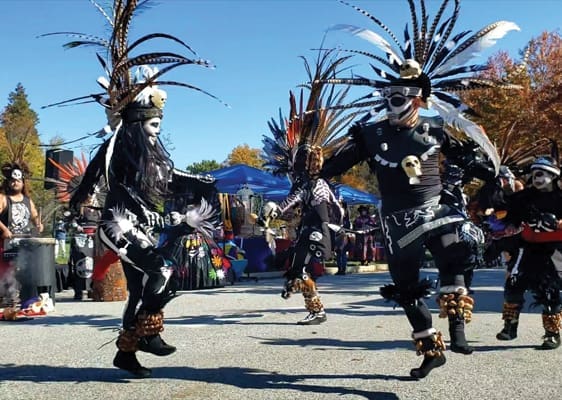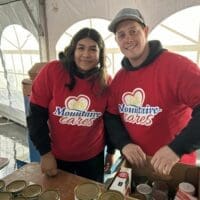Día de los Muertos: Walking Among the Ancestors
The Delaware Art Museum presents the fourth annual Día de los Muertos: Walking Among the Ancestors event on Saturday, October 28, 11 a.m. – 4 p.m. Guests of all ages can experience a variety of activities, such as an Indigenous ceremony, labyrinth walk, and contribute to ofrendas by bringing pictures of loved ones and food to leave at the altars.
Opening ceremonies from Danza Azteca Anahuac, La Catrinamia, Seylin Abarca, Mr Capo 302, Ballet Folklorico Mexcio Lindo, Esmeralda LaCor, Mariachi Arrieros. Food stand by Los Taquitos de Puebla. Hosted by Jazmin Buke.


Honoring the Deceased with Joyful Remembrance on Día de los Muertos:
Día de los Muertos, or the Day of the Dead, is a vibrant and meaningful Mexican holiday celebrated on November 1st and 2nd each year. While it may share some similarities with Halloween, it is fundamentally different in its purpose, traditions, and cultural significance. Día de los Muertos is a beautiful and colorful celebration of life and a way to honor and remember deceased loved ones.
Origins and Significance
The origins of Día de los Muertos can be traced back to the indigenous peoples of Mexico, particularly the Aztecs, who believed that death was a natural part of the human experience. They saw it as a transition rather than an end and considered it important to maintain a connection with deceased loved ones. When the Spanish conquistadors arrived in the 16th century, they attempted to suppress indigenous traditions, including those related to death. However, over time, these traditions merged with Catholicism, creating the modern-day Día de los Muertos.
The holiday is a joyful and colorful affirmation of life and a way to remember and celebrate the deceased. It is not meant to be a somber occasion but a festive one, filled with love, laughter, and beautiful altars and ofrendas (offerings) to honor the departed.
Ofrendas and Altars
Central to the celebration of Día de los Muertos are the ofrendas and altars. Families create these elaborate displays in their homes and at the gravesites of their loved ones. These ofrendas are meticulously designed with a variety of items that hold symbolic significance. They typically include marigold flowers, known as cempasúchil, to guide the spirits of the deceased to the altars, as well as their favorite foods, beverages, and personal belongings.
Calaveras (sugar skulls) and pan de muerto (bread of the dead) are common offerings on these altars. The sugar skulls are intricately decorated with bright colors and the names of the deceased, while pan de muerto is a sweet, skull-shaped bread adorned with strips of dough to represent bones.
Candles and Incense
Candles and incense are also crucial elements of Día de los Muertos altars. They are believed to light the way for the spirits to return to the living world. The warm glow of candlelight creates a mystical ambiance that invites the departed to visit their earthly homes once more.
La Catrina: The Iconic Symbol
One iconic symbol associated with Día de los Muertos is La Catrina. La Catrina is an elegantly dressed skeleton lady who has become the embodiment of the holiday. Created by artist José Guadalupe Posada, she serves as a reminder that death is an equalizer, affecting both rich and poor. La Catrina’s image is often seen in the form of colorful paintings and sculptures and adorns many Día de los Muertos celebrations.
Community and Family Involvement
Día de los Muertos is a holiday that fosters a strong sense of community and family. Families come together to create ofrendas, visit cemeteries, and celebrate the lives of their loved ones. There is a sense of togetherness and unity as people share stories, memories, and laughter, even in the face of death.
Parades and Festivities
In addition to private family gatherings, there are public celebrations in many Mexican cities. One of the most famous of these is the annual parade in Mexico City, which has gained international recognition thanks in part to the animated movie “Coco.” These parades feature vibrant costumes, large, intricately designed puppets, and live music. They provide an opportunity for locals and tourists to come together and experience the joy and beauty of Día de los Muertos.
Global Recognition and Influence
Día de los Muertos has transcended its Mexican origins and gained recognition around the world. In the United States, for example, it is celebrated by people of Mexican descent and has influenced the broader culture. Elements like sugar skulls and face painting have made their way into mainstream Halloween celebrations.
Preservation of Tradition
While Día de los Muertos has become more widely known, it’s essential to remember its roots and cultural significance. Many efforts are made to preserve and protect the authentic traditions associated with this holiday. For the Mexican people, it is a deeply meaningful and heartfelt celebration of their cultural heritage and the memory of their ancestors.
Día de los Muertos is a unique holiday that blends indigenous traditions with Catholicism to create a vibrant celebration of life and remembrance of the deceased. It is a time for families to come together, create colorful ofrendas, and celebrate the lives of their loved ones who have passed away. The holiday’s global recognition and influence highlight the importance of cultural exchange and the power of tradition to transcend borders. Día de los Muertos is a testament to the resilience of tradition and the enduring human need to remember and honor our departed loved ones with joy and celebration.
Find more about the event in Delaware at https://delart.org/event/diadelosmuertos2023/
Share this Post




